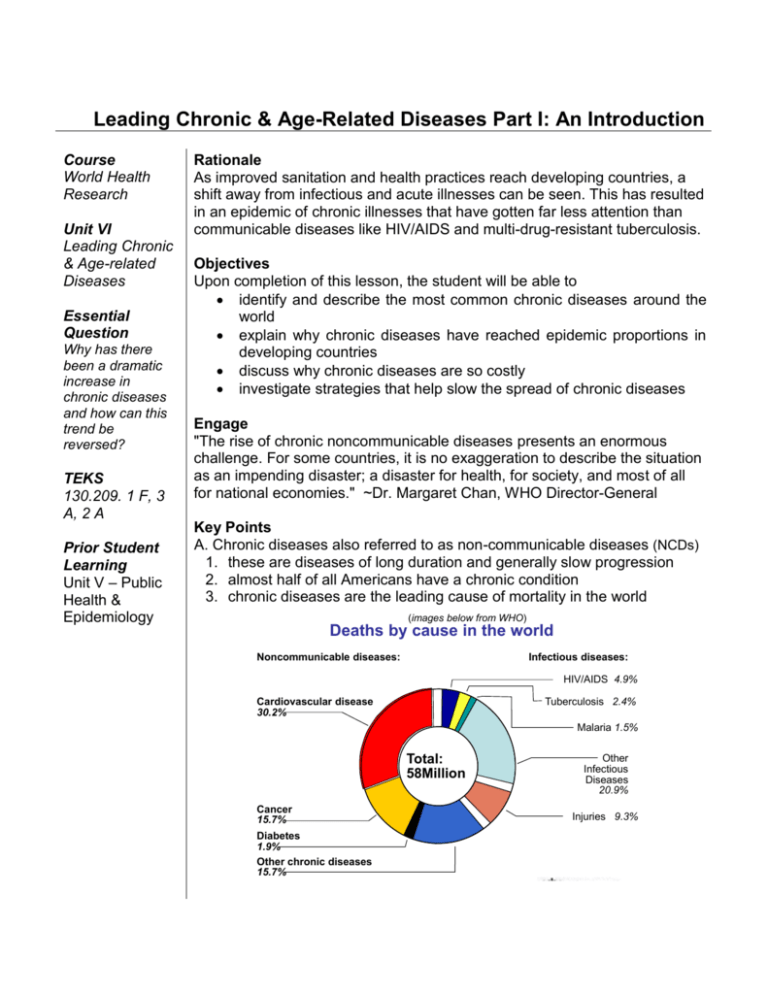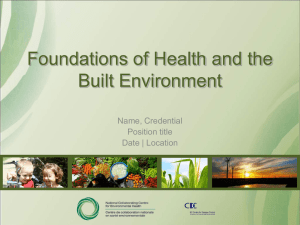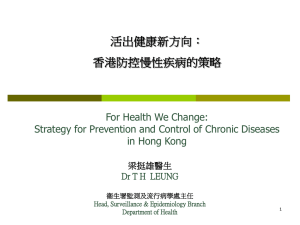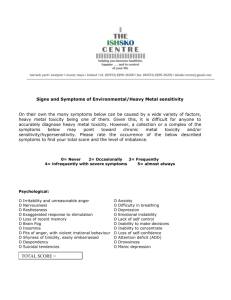
Leading Chronic & Age-Related Diseases Part I: An Introduction
Course
World Health
Research
Unit VI
Leading Chronic
& Age-related
Diseases
Essential
Question
Why has there
been a dramatic
increase in
chronic diseases
and how can this
trend be
reversed?
TEKS
130.209. 1 F, 3
A, 2 A
Prior Student
Learning
Unit V – Public
Health &
Epidemiology
Rationale
As improved sanitation and health practices reach developing countries, a
shift away from infectious and acute illnesses can be seen. This has resulted
in an epidemic of chronic illnesses that have gotten far less attention than
communicable diseases like HIV/AIDS and multi-drug-resistant tuberculosis.
Objectives
Upon completion of this lesson, the student will be able to
identify and describe the most common chronic diseases around the
world
explain why chronic diseases have reached epidemic proportions in
developing countries
discuss why chronic diseases are so costly
investigate strategies that help slow the spread of chronic diseases
Engage
"The rise of chronic noncommunicable diseases presents an enormous
challenge. For some countries, it is no exaggeration to describe the situation
as an impending disaster; a disaster for health, for society, and most of all
for national economies." ~Dr. Margaret Chan, WHO Director-General
Key Points
A. Chronic diseases also referred to as non-communicable diseases (NCDs)
1. these are diseases of long duration and generally slow progression
2. almost half of all Americans have a chronic condition
3. chronic diseases are the leading cause of mortality in the world
(images below from WHO)
Deaths by cause in the world
Noncommunicable diseases:
Infectious diseases:
HIV/AIDS 4.9%
Tuberculosis 2.4%
Cardiovascular disease
30.2%
Malaria 1.5%
Total:
58Million
Cancer
15.7%
Diabetes
1.9%
Other chronic diseases
15.7%
(WHO, 2004)
Other
Infectious
Diseases
20 9%
20.9%
Injuries 9.3%
2
B. The only continent where infectious diseases out number chronic
diseases is Sub-Saharan Africa.
C. Reasons for shift from infectious diseases
1. sanitation and better living conditions
2. better health practices and improved medical care
3. worldwide health education
D. Common causes for the increase of chronic diseases
1. people living longer
a. prone to chronic disease as we age
b. about 80% of senior population has one or more chronic conditions
twenty-five% are limited in their ability to perform activities of
daily living
2. poor eating habits (fast foods, not enough fruits & vegetables)
3. lack of physical activity
4. rise in obesity
5. tobacco use (rising consumption in developing countries)
6. excessive alcohol consumption
7. pollution
8. globalization
E. Most common NCDs:
1. cardiovascular disease
a. primarily myocardial infarction and stroke
b. valve disease and congenital heart anomalies
i. over past two decades cardiovascular disease has decreased
in high-income countries, but increased in low- and middle-
Copyright © Texas Education Agency, 2014. All rights reserved.
3
income countries largely due to lifestyle choices (poor diet,
lack of exercise, smoking, excessive use of alcohol)
c. lung disease
a. chronic obstructive pulmonary disease (COPD): chronic asthma,
chronic bronchitis, emphysema
b. incidence of these diseases increasing throughout the world due to
smoking and air pollution
c. diabetes
a. World Health Organization reports that 4.6 million people die each
year from diabetes.
b. most of these cases are related diabetes type II
c. diabetes type II is linked to obesity, poor diet, and lack of exercise
d. cancer
a. number of cancer deaths worldwide is projected to increase by
45% by 2030
b. deadly cancers that are increasing at a high rate: lung, stomach,
colon, liver, and breast
c. most cancer cases are now found in the developing world
d. only 30% of cancer cases are linked to behavioral or
environmental factors (tobacco being the single largest
preventable behavior)
F. The burden of chronic disease
1. people with chronic conditions account for 83% of all health care
spending in the United States
2. projected that by 2020, chronic diseases will account for almost ¾ all
deaths worldwide
3. globally speaking, 60% of the burden of chronic diseases will occur in
developing countries
4. people with chronic diseases are heaviest users of health care services
a. fill more prescriptions
b. visit physicians more frequently
c. likely to be hospitalized and have more inpatient stays
d. have more home health care visits
5. people with chronic illness tend to have likely to have activity limitations
G. The future cost of chronic diseases
1. the economic burden of chronic diseases is rapidly increasingly
worldwide
2. the proportion of the burden of NCDs is expected to increase to 57% by
2020
Estimated time
Activity I:
Investigation: 55 min
Presentation &
Discussion: 35 min
Activity
I. Groups will investigation, present and discuss how chronic diseases
affect the Native American populations. Some good resources to help
students get started:
Copyright © Texas Education Agency, 2014. All rights reserved.
4
II.
Activity II:
Investigation: 15 min
Discussion: 15 min
Activity III:
Investigation: 55 min
Project: 55 min
Activity IV:
Investigate & design
project: 3-4 classes
Coordinate &
implement project:
teacher’s discretion
http://www.cdc.gov/minorityhealth/populations/REMP/aian.html
http://ruralhealth.und.edu/projects/nrcnaa
http://en.wikipedia.org/wiki/Native_American_disease_and_epidemics
http://www.nativevillage.org/Libraries/Health%20Library.htm
video: http://www.bhcaih.org/protectvideo.html
Investigate and discuss major CDC efforts to help prevent chronic
diseases. (see list under Major Programs at the following site:
http://www.cdc.gov/chronicdisease/about/programs.htm)
III. Following the HOSA Public Service Announcement event guidelines
and rating sheet, groups will create a public service announcement
about one of the following chronic illnesses: myocardial infarction,
stroke, asthma, skin cancer, diabetes.
IV. Following the HOSA Community Awareness event guidelines and
rating sheet, the class will develop and sponsor a project to promote
community awareness about one of the chronic diseases that is
prevalent in Texas.
Assessment
Successful completion of CheckPoint Test (found on PowerPoint).
Materials
PowerPoint & KEY
Student computers
HOSA Public Service Announcement event guidelines
HOSA Public Service Announcement grading rubric (Judge’s Rating Sheet)
HOSA Community Awareness event guidelines
HOSA Community Awareness grading rubric (Judge’s Rating Sheet)
Accommodations for Learning Differences
I. For reinforcement, the student will view one of the following global
chronic disease online videos: WHO: Unite in the fight against NCDs
(runtime: 6:22); WHO: Global Noncommunicable Disease Network
(runtime: 6:22); Obesity and Type 2 Diabetes (HBO: The Weight of
the Nation) (runtime: 12:21); Land of Tobacco: China’s deadly
addiction (runtime: 2:02)
National and State Education Standards
National Health Science Cluster Standards
HLCO2.01
Health care workers will know the various methods of giving and obtaining
information. They will communicate effectively, both orally and in writing.
HLCO4.01
Health care workers will use information technology applications required
Copyright © Texas Education Agency, 2014. All rights reserved.
5
within all career specialties. They will demonstrate use as appropriate to
health care applications.
TEKS
130.209 (c) 1C contrast health problems in developing and developed
countries;
130.209 (c) 1F identify and describe the challenges in global health, which
have the greatest impact on health in developing nations;
130.209 (c) 7B presents project to classmates.
Texas College Readiness Standards
English Language Arts
III. A. Understand the elements of communication both in informal group
discussions and formal presentations (e.g., accuracy, relevance, rhetorical
features, and organization of information).
III. B. Develop effective speaking styles for both group and one-on-one
situations.
IV. A. Apply listening skills as an individual and as a member of a group in a
variety of settings (e.g., lectures, discussions, conversations, team projects,
presentations, interviews).
IV. B. Listen effectively in informal and formal situations.
V. B. Select information from a variety of sources.
Cross-Disciplinary
I. A. 1. Engage in scholarly inquiry and dialogue.
1. E. 1. Work independently.
1. E. 2. Work collaboratively.
1F.2. Evaluate sources for quality of content, validity, credibility, and
relevance.
II. C. 1. Understand which topics or questions are to be investigated.
II. C. 2. Explore a research topic.
II. C. 5. Synthesize and organize information effectively.
II. C. 8. Present final product
II. E. 1. Use technology to gather information.
References:
Centers for Disease Control and Prevention (CDC): http://www.cdc.gov/
World Health Organization (WHO): http://www.who.int/en/
National Cancer Institute: http://www.cancer.gov/
National Association of Chronic Disease: http://www.chronicdisease.org/
The Silver Book—Aging and Chronic Disease: www.silverbook.org/SilverBook.pdf
The Value of Elderly Disease Prevention, Goldman et al. 2005
Copyright © Texas Education Agency, 2014. All rights reserved.
6
PBS News Hour – Non-Communicable Disease Primer: Where Does the World Stand?
http://www.pbs.org/newshour/rundown/2011/09/non-communicable-disease-primer-where-doesthe-world-stand.html
Copyright © Texas Education Agency, 2014. All rights reserved.
7
NAME ________________________
CLASS ________
DATE____________
CheckPoint Test
Chronic & Age-Related Diseases
1. What is another name for chronic diseases?
2. How would you define chronic disease?
3. Approximately how many people in the U.S. have a chronic condition?
4. What is the only continent in the world where infectious diseases outnumber chronic
conditions?
5. Name one reason for the shift from infectious diseases to chronic diseases.
6. Which of the following is not a cause of a chronic disease.
a. rise in obesity
b. increased travel around the world
c. don’t eat enough vegetables & fruit
7. What % of world’s elderly has one or more chronic diseases?
8. In the past 2 decades cardiovascular disease has decreased in: (select all that apply)
a. low-income countries
b. middle-income countries
c. high-income countries
d. sub-Saharan Africa
9. Name two lifestyle choices that largely contribute to cardiovascular disease.
Copyright © Texas Education Agency, 2014. All rights reserved.
8
10. What does COPD stand for?
11. What are the 2 major causes of COPD around the world?
12. What type of diabetes is linked to poor diet and obesity
a. Diabetes Type I
b. Diabetes Type II
13. Name one of the top 11 countries where there is a high prevalence of diabetes.
14. Name 2 of the deadly forms of cancer that are increasing at a high rate around the world.
15. What % of cancer cases are linked to behavioral or environmental factors?
16. Name 2 ways in which people with chronic conditions burden our health care system.
Copyright © Texas Education Agency, 2014. All rights reserved.
9
KEY
CheckPoint Test
Chronic & Age-Related Diseases
1. What is another name for chronic diseases?
non-communicable diseases
2. How would you define chronic disease?
a non-infectious disease of long duration and slow progression
3. Approximately how many people in the U.S. have a chronic condition?
almost half of all Americans
4. What is the only continent in the world where infectious diseases outnumber chronic
conditions?
Sub-Saharan Africa
5. Name one reason for the shift from infectious diseases to chronic diseases.
people living longer
poor eating habits
lack of physical activity
rise in obesity
tobacco use
excessive alcohol consumption
pollution
globalization
6. Which of the following is not a cause of a chronic disease.
a. rise in obesity
b. increased travel around the world
c. don’t eat enough vegetables & fruit
7. What % of world’s elderly has one or more chronic diseases?
80%
8. In the past 2 decades cardiovascular disease has decreased in: (select all that apply)
a. low-income countries
b. middle-income countries
c. high-income countries
d. sub-Saharan Africa
9. Name two lifestyle choices that largely contribute to cardiovascular disease.
poor diet, lack of exercise, smoking, excessive alcohol
Copyright © Texas Education Agency, 2014. All rights reserved.
10
10. What does COPD stand for?
Chronic Obstructive Pulmonary Disease
11. What are the 2 major causes of COPD around the world?
smoking & air pollution
12. What type of diabetes is linked to poor diet and obesity
a. Diabetes Type I
b. Diabetes Type II
13. Name one of the top 11 countries where there is a high prevalence of diabetes.
Nauru, UAE (United Arab Emirates), Saudi Arabia, Bahrain, Kuwait, Oman, Tonga,
Mauritius, Egypt, Mexico, India
14. Name 2 of the deadly forms of cancer that are increasing at a high rate around the world.
lung cancer, stomach cancer, colon cancer, liver cancer, breast cancer
15. What % of cancer cases are linked to behavioral or environmental factors?
30%
16. Name 2 ways in which people with chronic conditions burden our health care system.
fill more prescriptions, visit physicians more, likely to be hospitalized more, have
more home health care visits
Copyright © Texas Education Agency, 2014. All rights reserved.
11
EVENT GUIDELINES
PUBLIC SERVICE ANNOUNCEMENT
JUDGE’S RATING SHEET
Section
Level:
SS
Team #
Judge’s Signature
Areas Evaluated
Organization and Content
Technical Quality
Presentation
Points
Awarded
Points Possible
Superior
Purpose (relevant, powerful message,
important information)
PS/C
Excellent
Good
Fair
Poor
10
8
6
4
2
10
8
6
4
2
5
4
3
2
1
Writing (clear wording, appropriate
language, accurate information)
5
4
3
2
1
Originality
10
8
4
2
Visual imagery (visuals support
message, realistic setting)
5
4
3
2
1
Talent (actors believable and realistic)
5
4
3
2
1
Audio (balanced background music,
silence used effectively)
5
4
3
2
1
Exposure/Focus/Color (sharp images,
good lighting)
5
4
3
2
1
Camera Technique/Composition
(movement, appropriate angles)
5
4
3
2
1
Editing/clean transitions/
synchronization
5
4
3
2
1
Demonstrated a clear understanding of
subject/theme and purpose of the PSA
10
8
4
2
5
4
3
2
1
5
4
3
2
1
72
54
36
18
Effectiveness (captures attention, the
critical message stands out, evokes
emotion)
Treatment (effective for target audience,
encourages positive behavior)
Described the creative process and how
they think the public has/will respond to
their PSA.
Spoke clearly and distinctly with good
grammar and articulation
PSA is 29-31 seconds in length
5
Presentation by at least 3 team members
5
Points Possible
100
6
6
Total Points
Public Service Announcement Guidelines (July 2011)
Copyright © Texas Education Agency, 2014. All rights reserved.
7
12
EVENT GUIDELINES
COMMUNITY AWARENESS
JUDGES’ RATING SHEET
Team #: ______________
Level ________ SS ________ PS/Collegiate
Section _______________
Judge's Signature:__________________________
Points Possible
Superior Excellent Good
Items Evaluated
Fair Poor
1. Scope and intensity of project.
Development and implementation.
10
8
6
4
2
2. Understanding of the specific health
issue.
10
8
6
4
2
3. Cooperative work with other groups to
reach goals of project
10
8
6
4
2
4. Impact on groups & individuals within
the community. (Increased public
awareness of the health-related issue.)
10
8
6
4
2
5. Imagination and creativity of the
project.
10
8
6
4
2
5
4
3
2
1
10
8
6
4
2
5
4
3
2
1
5
4
3
2
1
10
8
6
4
2
10
8
6
4
2
76
57
38
19
6. Interview Presentation
• Organization/teamwork
• Delivery (poise, speaking skills)
7. Responses to judge questions
8. Portfolio
• Written summary
• Project documentation
• Neatness, design, appearance
9. Followed guidelines for portfolio
5
TOTAL SCORE
100
Awarded
Copyright © Texas Education Agency, 2014. All rights reserved.
Community Awareness Guidelines (July 2011)
5









